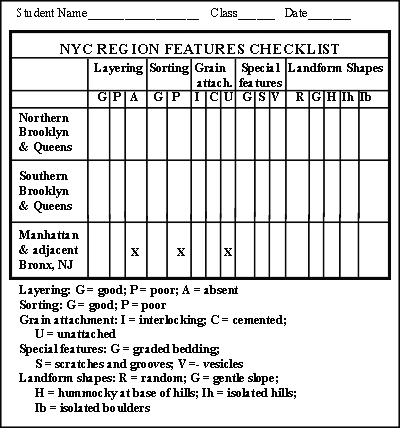|
NOW, ANALYZE THE DATA:
-
Now determine whether the features you have marked on your Depositional
Features Checklist are shown by the materials and landforms of the NYC
Region:
-
Print out the NYC Features Checklist (printout # H-5). A picture of the
Checklist is shown on the right.

This checklist has a column for each of the 16 features indicative
of deposition. It has three rows, one for each of the three distinctive
landform regions of the NYC Region: Northern Brooklyn & Queens; Southern
Brooklyn & Queens; Manhattan & adjacent Bronx, NJ.
-
To fill out this check list, you need to access two sources that have data
about the landforms of the NY City Region.
-
Click on the grey button shown on the right. It will open a separate window
that will allow you to re-examine the 'Statement of the Problem'. Read
the text and look at the images accessed by clicking on the square, grey
buttons. If you discover any of the 16 features that may be indicative
of deposition, place a mark in the appropriate box on the NYC Features
Checklist.
For example, the 'Statement of the Problem'
web page gives you access to pictures of boulders. It may be seen that
they are located in Manhattan and adjacent Bronx, NY; that they don't form
layers; and that they are loose on the surface. So, three boxes on the
bottom row of the NY Features Checklist may be marked with an 'x' (see
the picture of the Checklist). As other features are discovered, they may
be marked appropriately.
-
Similarly, click on the grey button on the right to open a separate window
that will show you the 'Map of Surficial Geology - NYC Region'. Examine
the images that appear when you roll the cursor over the map. If you discover
any of the 16 features that may be indicative of deposition, place a mark
in the appropriate box in your printout of the NYC Features Checklist.
|
PICTURE OF THE NYC FEATURES CHECKLIST

|
|
|
|
